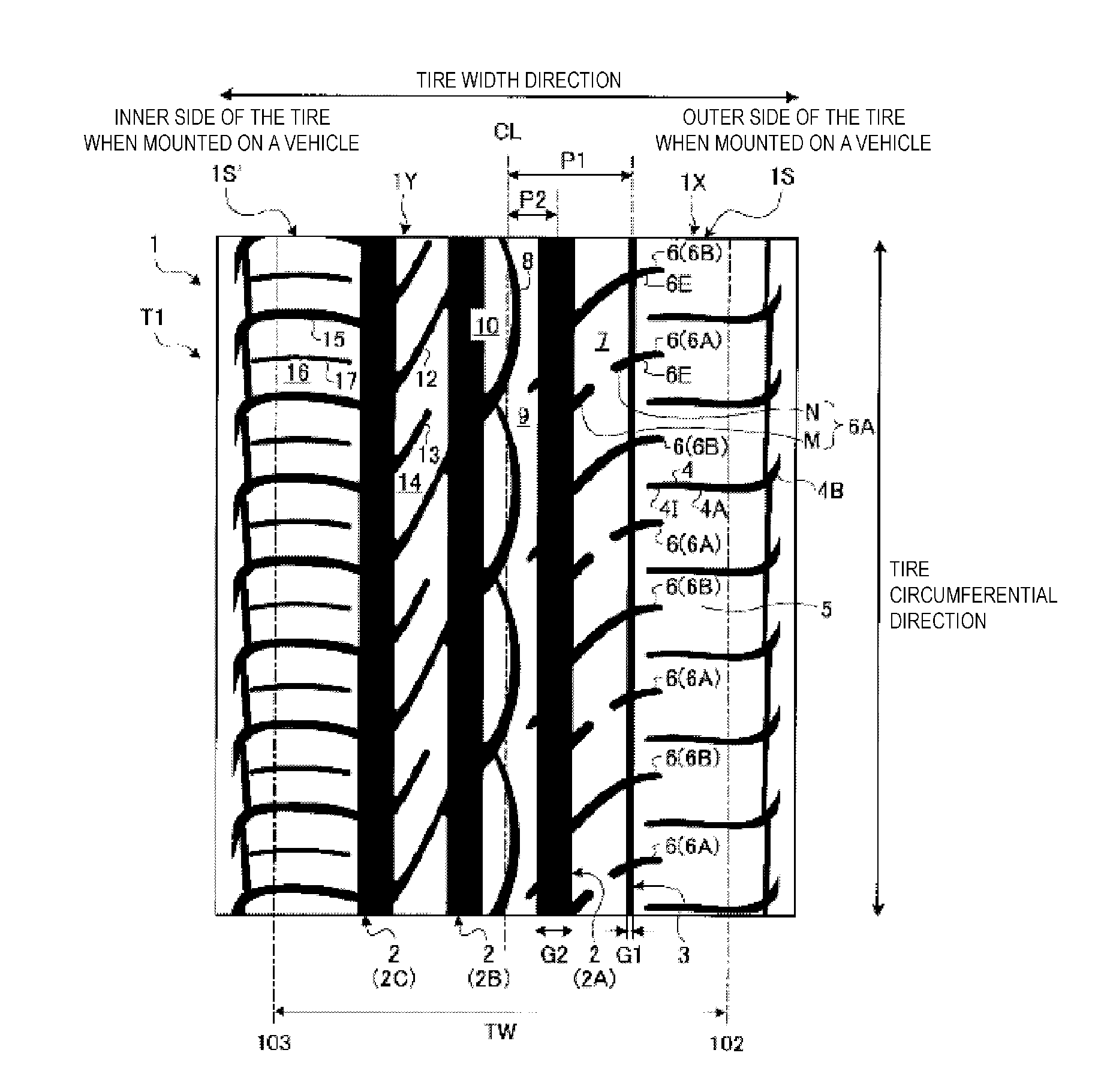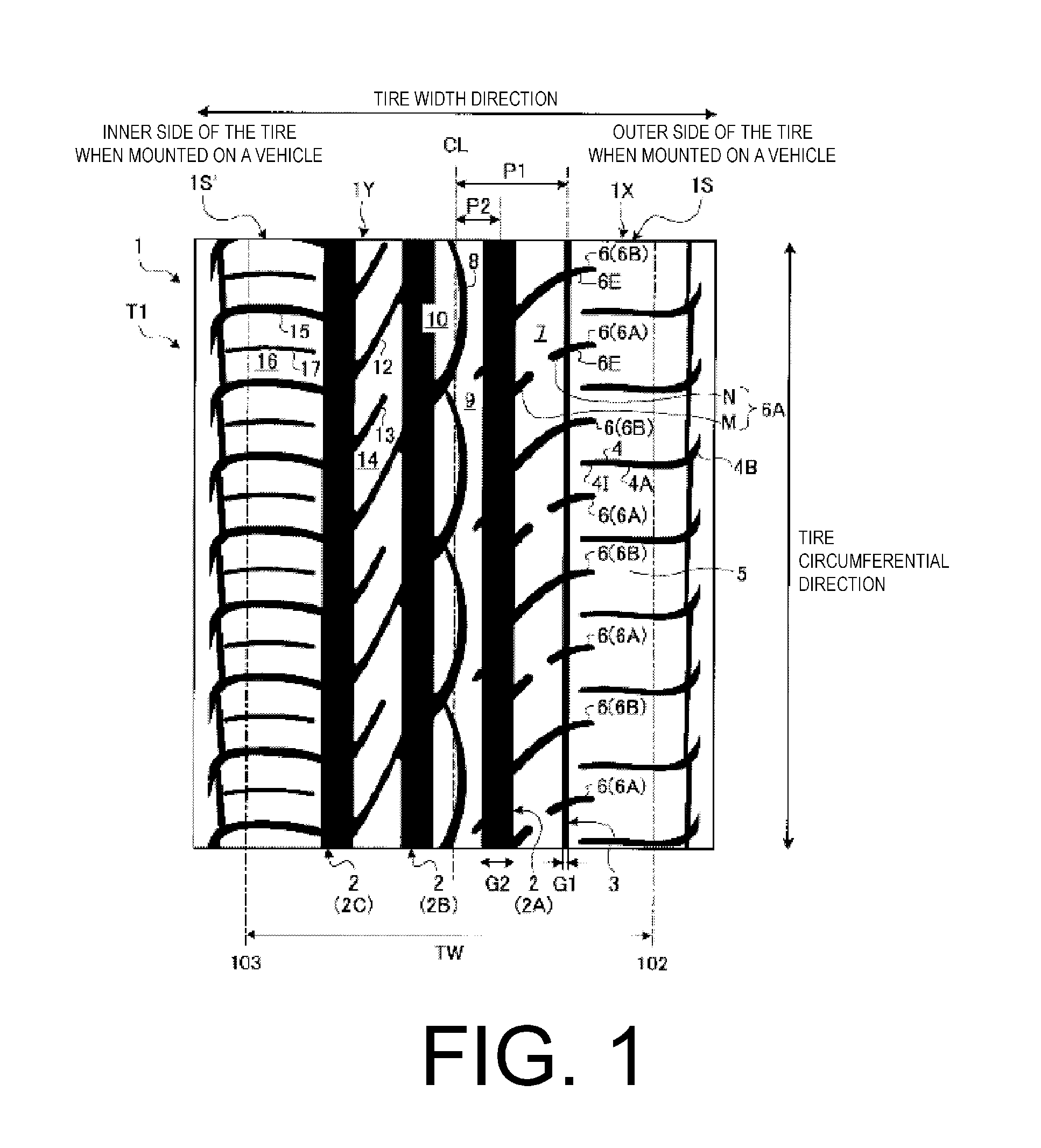Pneumatic tire
a technology of pneumatic tires and treads, applied in the field of pneumatic tires, can solve the problems of increased wear, decreased durability, and abnormal wear and cracking of the tread surface, and achieve the effect of steering stability, desired tire performance, and steering stability
- Summary
- Abstract
- Description
- Claims
- Application Information
AI Technical Summary
Benefits of technology
Problems solved by technology
Method used
Image
Examples
embodiment 1
[0035]FIG. 1 is a plan view illustrating a tread surface of a pneumatic tire of embodiment 1. A pneumatic tire T1 illustrated in FIG. 1 has a designated mounting direction when mounted on a vehicle, and is configured so that the side right of a tire ground contact center line CL is the outer side of the tire when mounted on a vehicle. Here, “tire ground contact center line CL” refers to a center line in the tire width direction in a tread contact patch when the pneumatic tire T1 is assembled on a regular rim, inflated to a regular pressure, and when loaded with a designated load. “Regular rim” refers to a “standard rim” defined by JATMA, a “Design Rim” defined by the Tire and Rim Association, Inc. (TRA), or a “Measuring Rim” defined by the European Tyre and Rim Technical Organisation (ETRTO). “Regular inner pressure” refers to the “maximum air pressure” defined by JATMA, the maximum value in “tire load limits at various cold inflation pressures” defined by TRA, and the “inflation pr...
embodiment 2
[0068]Next, a description of Embodiment 2 will be given. Embodiment 2 differs from Embodiment 1 in that a circumferential main groove is positioned on the tire ground contact center line CL.
[0069]FIG. 4 is a plan view illustrating a tread surface of a pneumatic tire of embodiment 2. Only the differences from the example illustrated in FIG. 1 (Embodiment 1) will be described for the example illustrated in FIG. 4 (Embodiment 2). Note that in FIG. 4, those constituents that have the same reference numerals as in FIG. 1 are identical to the constituents illustrated in FIG. 1.
[0070]In the pneumatic tire T2 illustrated in FIG. 4, four circumferential main grooves 2 extending linearly in the tire circumferential direction are provided in a tread surface 31. The tread surface 31 includes an outer side region 1X positioned outward of the tire ground contact center line CL when the tire is mounted, and an inner side region 1Y positioned inward of the tire ground contact center line CL when th...
examples
[0083]Pneumatic tires according to the embodiments, conventional example, and comparative examples were manufactured and evaluated. Note that the pneumatic tires according to the embodiments are working examples. The comparative examples are not the same as the conventional example.
PUM
 Login to View More
Login to View More Abstract
Description
Claims
Application Information
 Login to View More
Login to View More - R&D
- Intellectual Property
- Life Sciences
- Materials
- Tech Scout
- Unparalleled Data Quality
- Higher Quality Content
- 60% Fewer Hallucinations
Browse by: Latest US Patents, China's latest patents, Technical Efficacy Thesaurus, Application Domain, Technology Topic, Popular Technical Reports.
© 2025 PatSnap. All rights reserved.Legal|Privacy policy|Modern Slavery Act Transparency Statement|Sitemap|About US| Contact US: help@patsnap.com



